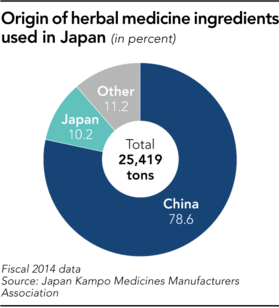Our gut on diet and nutrition- a Japanese model- the good and bad
Nov
11
Despite these indicators over decades, Japanese health care spending per capita remains far below that of the west, especially the United States. The argument is that proper diet and nutrition by itself can fight off the chronic diseases to which most people are susceptible. A growing amount of data and research points toward the critical role microorganisms play relative to nutrition in our individual health. Research at MIT, Harvard, UCLA, UCSD, UCSF, Stanford, Rockefeller University, to name a few, back claims with substantive research in different areas.
A January 31, 2018 article in the Nikkei Asian Review by Annu Nishioka, says herbal remedies are not only favored among the growing numbers of elderly Japanese that are keen on the products, an increasingly health-conscious younger generation is also starting to favor herbal remedies. However, it has created a sizable gap in the supply chain showing on the above graph. With supply from China capped out, experts say the gap must be filled domestically.
You do have doubters, but most agree that a better diet and nutrition leads to a healthier life. As quoted from a INC Magazine article (“A Space Entrepreneur has Launched Another Moonshot Venture . . . by Kevin Ryan, May 24, 2017), "If, for example, you follow 1,000 people who have a healthy lifestyle and 1,000 who don't," says Dr. Edward Giovannucci, a professor at Harvard's T.H. Chan School of Public Health, "without question there will be many more chronic diseases that develop in the 1,000 who don't have a healthy lifestyle.
But we have limited ability to predict specifically who will or will not develop diseases," according to Dr. Giovannucci. Giovannucci does agrees that healthy dieting generally leads to better health and fewer chronic conditions.
The bacteria inside our guts— which collectively make up the so-called gut microbiome— are incredibly diverse, with countless species and strains, he agrees. But they also differ depending on the individual, with one person’s microbiome having little to do with another’s.
As in all things, one must be cautious about applications of medicine, even in relation to Kampo herbal medicine. The May 29 study found conflicts between medicine and herbal remedies. It found that pseudoaldosteronism-related events, which are induced by Glycyrrhizae Radix, included several events related to muscle injury, heart failure, and arrhythmia. Events related to mesenteric phlebosclerosis, believed to be induced by long-term use of Kampo formulas containing Gardeniae Fructus, increased remarkably during the study period. Among the events related to drug eruption, approximately 35% were suspected to be induced by Kampo formulations containing Ephedrae Herba. See Dr. Enprnst report at https://edzardernst.com/2019/05/kampo-a-form-of-herbal-medicine-that-is-not-as-harmless-as-some-might-have-hoped/ .


